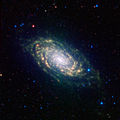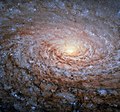Messier 63
Database links to Messier 63
Messier 63 (also referred to as NGC 5055) is a spiral galaxy with dimensions of 12.6′ × 7.2′ and apparent magnitude of 8.5 mag in the constellation of Hunting Dogs in the northern starry sky. Also called the Sunflower Galaxy, the object is about 25 million (or 30 or 37 million, depending on the source) light-years from the solar system and has a diameter of about 50,000 (65,000) light-years. Unusually and name-giving are the many, in the Spitzer-image particularly well visible, nodule-like condensations in its spiral arms, it concerns star formation areas and luminous gas clouds.
In very long exposure images, a stellar stream becomes visible in the form of an arc reaching out 14 arcminutes and only 1.6 arcminutes wide. A detailed study by Taylor S. Chonis et al. concludes that a dwarf galaxy with about 100 million solar masses was swallowed up here. In the process, the tidal interaction during the rupture also produced the wide stream of stars still visible today.
Also interesting is the very bright central region of M 63, which extends over about 1000 light-years. It surrounds an active core and exceeds its surrounding brightness by a factor of six, in H-alpha light even by a factor of 25. The rotational velocities measured here suggest a central black hole of almost one billion solar masses.
The object was discovered on 14 June 1779 by the French astronomer Pierre Méchain.
· 
Infrared image of the Spitzer space telescope
· 
UV recording by GALEX
· 
High-resolution image of the center taken by the Hubble Space Telescope
Search within the encyclopedia